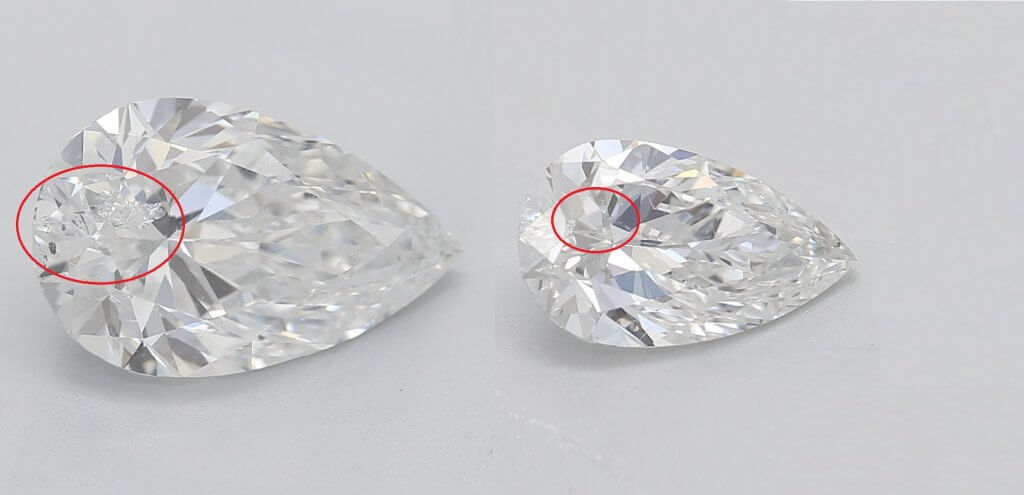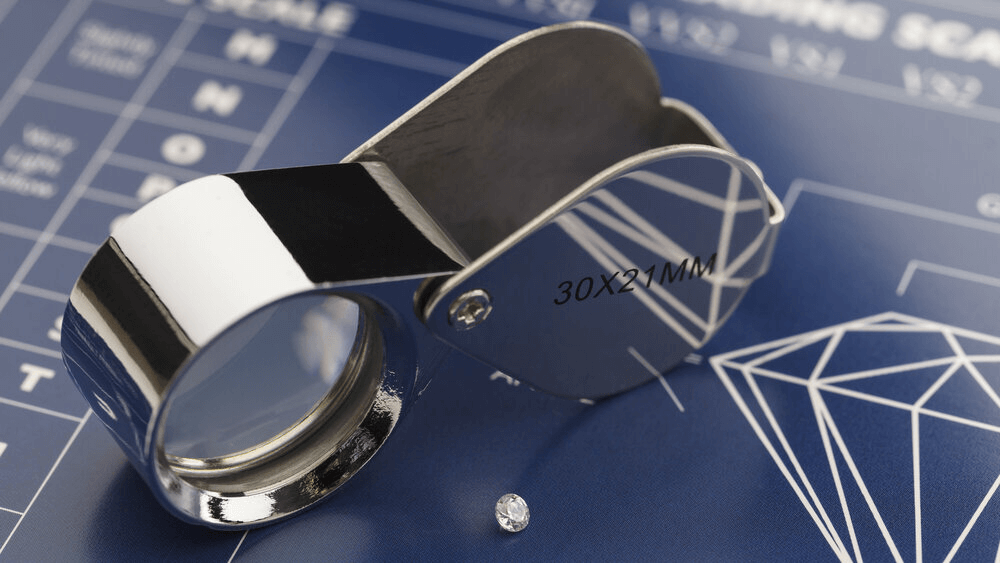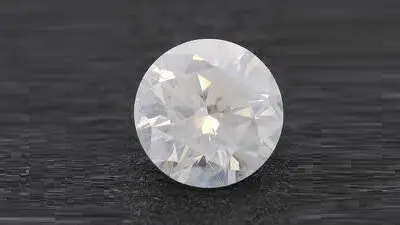SI2 Diamonds Clarity Exposed: The Truth Revealed

By Gary A.

Edited by Olivia H.
Published Sep 24, 2021
Edited on Mar 31, 2025
SI2 clarity diamonds offer a budget-friendly option, but are the inclusions noticeable enough to impact the sparkle, or could this be the hidden gem you’ve been searching for?

Navigate This Guide:
- 7 Quick Tips for Examining SI2 Diamond Clarity in Engagement Rings
- Introduction
- Understanding Diamond Clarity and SI2 Diamond Quality
- SI1 vs SI2: Spotting the Differences
- SI2 Diamond Price and Market Trends
- SI2 Clarity vs Shape
- Our Expert Take
- 10 FAQs
Before we dive deeper into the specifics, here are some practical tips to help guide your decision-making process:
7 Quick Tips for Examining SI2 Diamond Clarity in Engagement Rings
- Tip 1: Understanding the SI2 Clarity Grade Know What SI2 Entails: SI2 (Slightly Included 2) diamonds have inclusions visible under 10x magnification. Familiarize yourself with this clarity grade to set realistic expectations.
- Tip 2: Inspect the Inclusion Type and Location Focus on Inclusion Characteristics: Not all inclusions impact appearance equally. Look for diamonds where inclusions are not centrally located or are less visible, such as near the edges.
- Tip 3: Consider the Diamond’s Shape and Cut Shape and Cut Influence: Some diamond shapes hide inclusions better than others. For instance, round or oval cuts can mask inclusions more effectively compared to step cuts like emeralds.
- Tip 4: Evaluate the Diamond Under Different Light Conditions Lighting Matters: Examine the diamond under various lighting conditions. Inclusions may be more noticeable under bright light or direct sunlight.
- Tip 5: Prioritize Eye-Cleanliness Eye-Clean Aspect: While SI2 diamonds have visible inclusions under magnification, many are eye-clean. Ensure the inclusions are not visible to the naked eye.
- Tip 6: Balance SI2 Clarity with Other 4Cs Consider Overall Appeal: Don’t focus solely on clarity. A well-balanced diamond with good cut, color, and carat might offset the inclusions of an SI2 clarity grade.
- Tip 7: Compare SI2 Diamonds Side by Side Direct Comparison: If possible, compare multiple SI2 diamonds side by side. This can help you understand the variability within this clarity grade and choose the best option.
Now that you’ve got these practical tips, use Jeweler AI below to find the perfect engagement ring that suits your style and budget:
Introduction
We talk at length about eye cleanliness on WillYou.com. Alongside the diamond’s cut quality, a strong clarity grade is inarguably the most important thing to get right if you want to get the very most out of your engagement ring budget and present your future bride with a truly stunning diamond.
But, while cut quality is entirely down to the skill of the diamond cutter, a diamond’s clarity is (for the most part) something as random and as unique as a fingerprint. Yes, certain flaws can be removed during the cutting – and others can be caused if the diamond cutter is not careful enough – but, even so, clarity is a largely natural phenomenon.
What does this mean for you? It means that ‘eye cleanliness’ spans a pretty substantial section of the spectrum between totally flawless diamonds, and diamonds with intrusive inclusions. Great news if you’re looking to get the best quality possible without breaking beyond your original budget…
Understanding Diamond Clarity and SI2 Diamond Quality
Out of the Four Cs of diamond quality, clarity enjoys a slightly more open-ended spot on the list. True, it is vital that the diamond you invest into is eye clean (more on that below) but, at the same time, provided you get eye cleanliness down pat, the clarity grade you end up siding with is pretty irrelevant.
SI2 represents the second degree of the GIA clarity grade known as ‘Slightly Included’. It will typically mean that:
- The diamond in question will have been given a clarity grading of Slightly Included 2 on the GIA Clarity Scale
- Its inclusions will sometimes be obvious without magnification, but some SI2 diamonds will appear clean
- If you’re looking at two comparable diamonds, one with a grade of SI1 and the other with a grade of SI2, then the latter will likely be less expensive than the former.
- It could offer better value than the SI1 diamond, provided you choose carefully.
This grade sits past the halfway point on the GIA’s scale and, according to their own definition, means that the diamond’s inclusions are pretty easy for a skilled grader to identify under 10x magnification.
Sounds simple enough? It is not until you start realizing that some SI2 diamonds will feature noticeable inclusions – that is, inclusions that won’t require any sort of magnification to detect – while other SI2 diamonds will appear totally eye clean, and represent a great deal to buyers.
We’ll talk more about this below but, for now, keep in mind the fact that even eye clean SI2 diamonds can be thousands of dollars cheaper than diamonds with higher clarity grades, despite the fact that, without magnification, these diamonds can look pretty much identical.
The Role of Eye Cleanliness in Diamond Aesthetics
In diamonds, eye cleanliness means that, without magnification, a diamond appears to be free from any inclusions or blemishes.
As we mentioned above, eye cleanliness must be considered a priority by anyone looking to buy a diamond worthy of their engagement ring. With such small differences separating each of the clarity grades, it’s very easy for shoppers to track down diamonds that appear flawless in every respect except price.
For this reason, anyone preparing to invest in their own diamond should read our full guide to eye clean diamonds. A little research will save you thousands of dollars – or the heartache of ending up with a diamond that is undermined by its own inclusions and blemishes.
For now, however, you just need to keep in mind the fact that choosing to purchase a flawless diamond is, for most of us, as ill-advised as choosing to purchase a diamond that is far from eye clean…
Is it Possible to Find an Eye Clean SI2 Diamond?
There are definitely SI2 eye clean diamonds out there – and more than you might expect – although your options will be a little more limited at this grade.
Don’t take this as a reason not to bother looking at the SI2 clarity grade. In many cases, this is the best place to start a search – although anyone looking for a larger diamond, or one with a less forgiving shape (such as the step cut shapes Emerald and Asscher) will probably find more choices in the VS range.
Cloudiness in SI2 Diamond Quality
A cloudy diamond is generally one that is so included that it has a distinctly hazy or milky appearance.
This is caused by some pretty major cloud inclusions, and will, unfortunately, make the diamond appear lifeless and lacking in the high shine we all want for our engagement rings. If this is the case, then the diamond will likely be given a much, much lower clarity grade.
Alternatively, some diamonds with significant fluorescence can appear to be cloudy, and, while this will be noted within the stone’s GIA report, it will fall under its own category (not clarity). So, in theory, a diamond could be given a clarity rating of, say, VVS1 (very very slight inclusions 1) while suffering from significant fluorescence.
If you’re unsure, check the report.
SI2 Diamond Clarity and Sparkle
SI2 diamonds will feature a beautiful sparkle – provided, of course, that they are cut to a high standard.
If you haven’t found out about this already, then get used to hearing it: cut is the most significant factor behind sparkle.
For this reason, you’ll definitely want to do your research on ideal cut diamond proportions, and other factors like symmetry and polish. Getting your head around this – and, of course, which shapes offer the most in terms of brilliance, fire, and scintillation (AKA, sparkle) – will mean that you can avoid any heartache over dull or lifeless diamonds.
Nevertheless, it is true that significant inclusions can impair a diamond’s ability to sparkle as much as it otherwise could. Even so, diamonds of this quality would sit lower on the clarity scale – as low as I1 and I2 – and, provided it appears eye clean, you won’t have to worry about sacrificing any sparkle.
SI1 vs SI2: Spotting the Differences
So, which is better: SI1 or SI2? That depends. In terms of quality, the SI1 obviously wins out. In terms of price, the SI2 diamond will be a little more affordable – and a great option if it’s eye clean.
The key difference between SI1 and SI2 is typically down to the location of the stone’s inclusions. If they can be seen through the table, then the grade will be SI2. If, however, they’re only discernible when the diamond is viewed from below, the diamond will likely receive an SI1 grade.
It’s only worth paying for better clarity if you can see a difference without a magnifying glass. If you’re looking at two eye clean diamonds, one SI1 and the other SI2, then paying more for the SI1 diamond (even if it’s only a few hundred dollars) is not worth it.
But, if we’re generalizing, the SI1 grade will prove more useful to shoppers than SI2. You’ll have much more choice in terms of eye clean diamonds than you will at the SI2 mark so, unless you’ve already found an SI2 diamond you’re happy with, consider setting your sights a little higher.

The Round, Oval, Marquise and Cushion are just a few shapes that could offer plenty of choices at the SI2 clarity grade.
How inclusions influence value and appearance
The most obvious downside to the SI2 clarity grade is the fact that it could be a little tougher finding eye clean options – but it’s definitely not impossible.
One of the great things about VS diamonds is the fact that, for the most part, they’re all considered eye clean. This means that searching specifically for VS1 and VS2 diamonds will open you up to plenty of choices, whether you’re looking for a 3 carat Round diamond or a more modest 1.5 carat Emerald cut diamond.
The downside? Shoppers who narrow their sights on this clarity grade too soon could be closing themselves off to some even better deals – deals which leave more budget left over for the ring setting, or, instead, investing in a bigger diamond in the first place.
It’s not enough to find an eye clean diamond and roll with it. It’s about taking advantage of the lowest clarity grades that still offer beautiful, eye clean options that suit your vision for the ring.
So, while the SI2 clarity grade won’t offer the same number of options as SI1 or VS2, it’s more than worth taking a look for yourself.
SI2 Diamond Price and Market Trends
SI2 diamonds can represent a great deal – but they can also be just a little too far in the wrong direction – depending on the size and shape of diamond you’re looking at. Confused? Here’s everything you need to understand about paying for an SI2 diamond.
How Much is an SI2 Diamond?
There is no definitive price for SI2 diamonds since individual price tags are determined by the diamonds cut, color and carat weight, as well as clarity grade.
If you’re looking exclusively at SI2 clarity graded diamonds, then prices could vary from around $2,000+, with a high quality, one carat diamond costing around $5,000.
In other words, it’s impossible to put a price tag on SI2 diamond clarity. Instead, it’s better for you to get used to the idea that two diamonds with identical cut and color grades, and the exact same carat weight, could differ in price by hundreds – or even thousands – of dollars if one is SI2, and the other a higher grade.
So, how much does an SI2 diamond cost? Less than a diamond with a clarity grade of VS or VVS (all else being equal), which can make for an incredible deal that allows you to opt for a higher carat weight.
The catch? You may have a slightly harder time finding eye clean options. Yes, they exist, but the majority of SI2 diamonds do have some visible inclusions, so keep that in mind.
Is SI2 Worth the Price?
Potentially, but you should never jump into a deal. Always keep your options open until you are sure you have found the right diamond.
Eye cleanliness is, by definition, something we can only judge with our own eyes. This means that an SI2 diamond can be worth the price, but it’s probably not going to be the easiest grade to focus your search on. Then again, the only diamonds worth buying are those that offer the very best price – and, for some, that can mean SI2.
Don’t be deterred if you can see some minor inflections in the images – these will have been magnified many times over in order to give online shoppers the best possible insight into the diamond’s unique qualities.
SI2 Clarity vs Shape
Eye cleanliness is certainly possible at SI2, but one of the most significant factors that will determine whether or not you can find a good diamond is shape, with certain diamond shapes making it much harder than others.
Is SI2 Good For Step Cut Diamonds?
In most cases, no, SI2 is a little too low on the clarity scale for step cuts.
Why? Because step cuts feature much longer facets. Not only does this totally change the way those diamonds sparkle (when compared to a brilliant cut, like the traditional round diamond), but it also totally changes the view we get when we look down through the table.
Asscher and Emerald cut diamonds are known for their ‘hall of mirrors’ effect – something that, while beautiful, can make any minor inclusions much easier to detect. The chances of an SI2 step cut diamond bearing visible inclusions is, of course, made even higher as the size of the diamond you’re looking at increases.
In other words, what might work in an Oval or Marquise cut diamond, for instance, could easily turn into a dealbreaker in an Emerald or Asscher cut diamond. This is particularly true if the diamonds you are looking at are over half a carat in weight – something which tends to be the case for those picking out a center stone for their engagement ring.
Our Expert Take
Should you turn away from an eye clean, affordable SI2 diamond ring just because it’s got this low clarity grade? Absolutely not. While the chances of finding one of these diamonds are lower than the chances of finding one with a visible inclusion, a clarity grade of SI2 only matters if the stone in question is not eye clean.
It’s all too easy for first-time shoppers to assume that a relatively low clarity grade means more than it really does. Yes, the criteria for each grade differ significantly in the eyes of a skilled and experienced diamond grader, but, for the rest of us, it really is a case of ‘face value’.
Still, we’d recommend that you broaden your search to include SI1 and VS2 diamonds, in order to ensure that you’re not restricting yourself too much, since most shoppers today are on the hunt for a diamond of at least one carat (or considerably more).
10 FAQs
- Q: What is the main difference between SI1 and SI2 diamond clarity?
- A: The main difference lies in the visibility of inclusions. SI1 diamonds typically have inclusions that are only noticeable under 10x magnification, while SI2 diamonds may have inclusions visible to the naked eye.
- Q: Are SI1 diamonds always better than SI2?
- A: Not necessarily. It depends on the individual diamond. Some SI2 diamonds can appear as visually appealing as SI1 diamonds if the inclusions are well-placed or less noticeable.
- Q: How much does clarity affect a diamond’s price?
- A: Clarity significantly impacts price. Generally, SI1 diamonds are priced higher than SI2 due to better clarity, but prices also depend on other factors like cut, color, and carat.
- Q: Is it possible to find eye-clean SI2 diamonds?
- A: Yes, it is possible, though it requires careful inspection. Some SI2 diamonds have inclusions that are not visible to the naked eye, making them eye-clean.
- Q: Should I prioritize clarity over other aspects like cut or color?
- A: It depends on personal preferences and budget. While clarity is important, a well-cut diamond can compensate for lower clarity, and color preferences can vary.
- Q: Can I accurately judge diamond clarity online?
- A: Online judgements can be challenging. High-quality images and certifications can help, but in-person inspection is often more reliable for assessing clarity.
- Q: Are lab-grown diamonds better in terms of clarity?
- A: Lab-grown diamonds can have fewer inclusions, but natural and lab-grown diamonds can both offer high clarity levels. The choice depends on personal preference and ethical considerations.
- Q: Do SI1 and SI2 diamonds hold their value over time?
- A: Diamonds generally hold value, but it depends on market demand and overall quality. SI1 diamonds might hold value better due to higher clarity.
- Q; What should I look for in an SI1 or SI2 diamond to ensure quality?
- A: Look for a diamond that is eye-clean, well-cut, and has inclusions that don’t impact its brilliance or structural integrity. Certification and expert advice can also guide quality assessment.
- Q: Is GIA certification important for SI1 and SI2 diamonds?
- A: Yes, GIA certification is highly regarded for its accuracy and reliability, providing assurance about the diamond’s clarity and overall quality.
Explore SI2 diamonds with Jeweler AI’s personalized, AI-driven recommendations, tailoring your dream ring to perfection.
FOLLOW-UP GUIDE SERIES





















